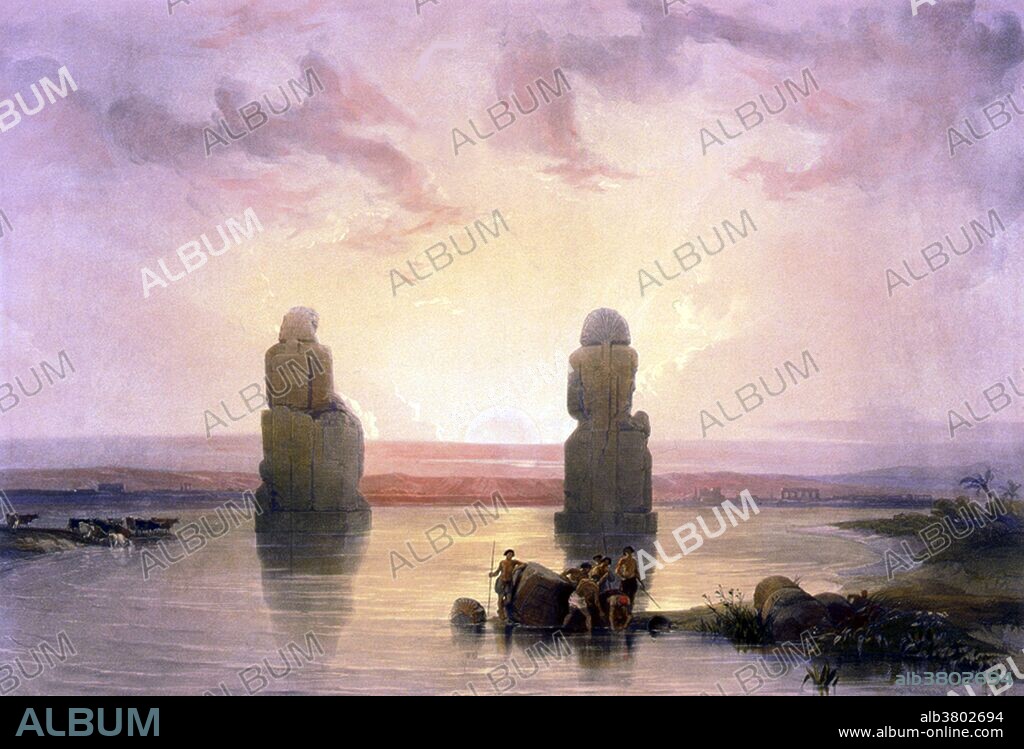alb3802694
Colossi of Memnon, Valley of the Kings, 1830s

|
Añadir a otro lightbox |
|
Añadir a otro lightbox |



¿Ya tienes cuenta? Iniciar sesión
¿No tienes cuenta? Regístrate
Compra esta imagen.
Selecciona el uso:

Título:
Colossi of Memnon, Valley of the Kings, 1830s
Descripción:
Ver traducción automática
Entitled: "Statues of Memnon at Thebes, during the inundation." The Colossi of Memnon are two massive stone statues of Pharaoh Amenhotep III. His reign was a period of unprecedented prosperity and artistic splendor, when Egypt reached the peak of her artistic and international power. For the past 3400 years (since 1350 BC) they have stood in the Theban necropolis. The Valley of the Kings is a valley in Egypt where, for a period of nearly 500 years from the 16th to 11th century BC, tombs were constructed for the Pharaohs and powerful nobles of the New Kingdom (the Eighteenth to the Twentieth Dynasties of Ancient Egypt). The valley stands on the west bank of the Nile, opposite Thebes (modern Luxor), within the heart of the Theban Necropolis. The royal tombs are decorated with scenes from Egyptian mythology and give clues to the beliefs and funerary rituals of the period. Almost all of the tombs seem to have been opened and robbed in antiquity, but they still give an idea of the opulence and power of the Pharaohs. This area has been a focus of archaeological and egyptological exploration since the end of the eighteenth century, and its tombs and burials continue to stimulate research and interest. In 1979, it became a World Heritage Site, along with the rest of the Theban Necropolis. David Roberts was a Scottish painter known for a series of detailed lithograph prints of Egypt and the Near East that he produced from sketches he made during long tours of the region (1838-1840).
Crédito:
Album / LOC/Science Source
Autorizaciones:
Modelo: No - Propiedad: No
¿Preguntas relacionadas con los derechos?
¿Preguntas relacionadas con los derechos?
Tamaño imagen:
4500 x 3060 px | 39.4 MB
Tamaño impresión:
38.1 x 25.9 cm | 15.0 x 10.2 in (300 dpi)
Palabras clave:
18 DINASTIA • 18. ª DINASTIA • 1838 • 18A DINASTIA • 18A. DINASTIA • 18ª DINASTIA • AMENHOTEP III • AMENOFIS III • ANTIGUO EGIPTO • ANTIGUO • ANTIGÜEDAD • ARQUEOLOGIA • ARQUEOLÓGICA • ARQUEOLOGICO • ARQUEOLÓGICOS • ARTE • CIENCIA • CIVILIZACION ANTIGUA • COLOSOS DE MEMNON • CULTURA ANTIGUA • DÉCIMO OCTAVA DINASTÍA • DECIMOCTAVA DINASTIA • DIBUJO • DINASTIA XVIII • EGIPCIO • EGIPTO • EGIPTOLOGIA • FAMOSA • FAMOSO • HISTORIA • HISTORICO • ILUSTRACION • IMPORTANTE • LITOGRAFIA • MONUMENTO • NECROPOLIS • OBRA DE ARTE • REINO NUEVO • RUINAS • SIGLO XIX • SÍTIO • TEBAS • TEMPLO • TUMBAS REALES • VALLE DE LOS REYES
 Pinterest
Pinterest Twitter
Twitter Facebook
Facebook Copiar enlace
Copiar enlace Email
Email
